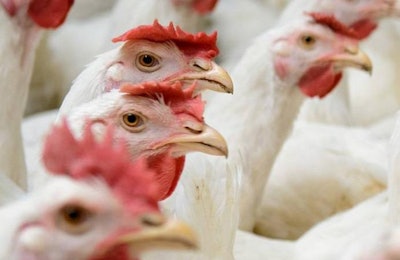
China has confirmed that two forms of highly pathogenic avian influenza (HPAI) have been detected at poultry farms for the first time this year, and new outbreaks have been confirmed in the last week in Bulgaria, Democratic Republic of the Congo, India, Iraq, Italy, Taiwan, and the United States.
For the first time in 2018, two subtypes of HPAI have been confirmed in Chinese poultry flocks. The country’s agriculture ministry has reported to the World Organisation for Animal Health (OIE) that the H5N6 and H7N9 virus variant have been detected in the poultry sector, each after an absence of around six months. In mid-February, the H7N9 virus subtype was found to be responsible for the deaths of the majority of 1,000 laying hens in a backyard flock in Tongchuan in the central province of Shaanxi. Within one week, the H5N6 HPAI virus was confirmed in a flock of more than 30,000 domestic ducks at a farm near Guilin city in the Guangxi autonomous region in central-southern China that borders Vietnam.
Following intensive surveillance of markets, farms and pet shops, authorities in Hong Kong have reported to the OIE finding no evidence of the spread of the H5N6 HPAI virus, which was detected in imported chicken in January.
Soon after confirming the H5N1 HPAI virus in mass mortality of house crows at Paradeep in Orissa state, India’s veterinary authority has reported to the OIE that the same virus was found in a backyard flock of 1,823 poultry in the same area. The birds were destroyed before showing clinical signs of the disease.
Two batches of red-feathered native chickens showing suspicious symptoms of HPAI at a wholesale market in Taipei last week have tested positive for the H5N2 virus variant, reports Taiwan News. The birds originated at a farm in Dacheng in Changhua county. All 68 birds have been destroyed.
The same virus was detected at a turkey farm in Yunlin county in February, according to the official report to the OIE. Of the 1,900 birds at the farm, 348 died and the rest have been destroyed.
Iraq’s number of HPAI outbreaks caused by the H5N8 virus variant has increased to 10, with cases at two farm in Diyala and Baghdad leading to the loss of almost 135,000 poultry through mortality or destruction.
In Japan, a total of 12 crows recently found dead at three locations in Itami city in Hyogo prefecture have tested positive for the H5N6 HPAI virus subtype.
Europe: HPAI returns to Italy
After an absence of almost three months, the H5N8 HPAI has returned to the Italian poultry sector. A flock of just over 96,000 laying hens in the Bergamo area of Lombardy showed signs of increased mortality and egg drop, and subsequently tested positive for the virus, reports the Italian health authority and research organization for animal health and food safety, IZSVe. In 2017, there were 83 confirmed outbreaks of HPAI linked to this virus subtype at Italian poultry farms.
Just one week after declaring Bulgaria free of the H5N8 HPAI virus to the OIE, the country’s veterinary authority has confirmed an H5 HPAI virus at a farm with 13,900 birds in Dobrich province in the north-east of the country. Around 3,500 birds died and the rest have been destroyed.
Four new outbreaks of low-pathogenic avian influenza of the H5N2 subtype have been revealed by pre-movement checks in flocks of French domestic waterfowl, according to the latest official report to the OIE. These bring the number of outbreaks linked to this virus to 52. All the latest cases were in ducks prior to gavage, with more than 37,000 birds destined for humane slaughter. All affected premises were in the west of France—two of the farms were in the department of Maine-et-Loire, one in Deux-Sèvres, and one in Sarthe.
In the Netherlands, all measures imposed to control the spread of the same virus have been lifted. The Dutch Ministry of Economic Affairs has reported to the OIE that no new cases have emerged in the three months following cleaning and disinfection of the only farm infected in October last year.
Africa: More HPAI in Democratic Republic of Congo
A further five outbreaks of HPAI linked to the H5N8 virus subtype have been belatedly reported to the OIE by the agriculture ministry in the Democratic Republic of the Congo. In November and December of 2017, five flocks of village ducks are reported to have been “decimated” by the disease in Mahagi territory, which is in the Ituri region in the north-east of the country. These bring the country’s total outbreaks to 31, all in the same region.
U.S. reports first cases of low-pathogenic avian influenza in poultry in 2018
Routine surveillance has revealed the first cases of low-pathogenic avian flu in the United States this year. None of the 20,000 commercial meat turkeys in Jasper County, Missouri, showed clinical signs of the infection, which was identified as belonging to the H7N1 subtype.















